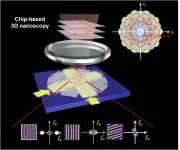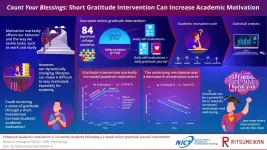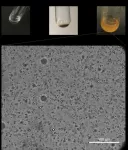Can the diffraction limit overcome in the linear imaging system?
A chip-compatible 3D nanoscopy answers
2021-05-13
(Press-News.org) Compared with the superresolution microscopy that bases on squeezing the point spread function in the spatial domain, the superresolution microscopy that broadens the detection range in the spatial frequency domain through the spatial-frequency-shift (SFS) effect shows intriguing advantages including large field of view, high speed, and good modularity, owing to its wide-field picture acquisition process and universal implementation without using special fluorophores labeling.
To enable spatial-frequency-shift microscopy with a superresolution at the subwavelength scale, it is essential to use the near-field evanescent wave with a larger wave vector than the far-field propagation wave for illumination, which can be built on the integrated photonics, paving the way for compact nanoscopy on a thin chip. In recent years, the research group led by Dr. Xu Liu and Dr. Qing Yang from Zhejiang University pioneered in using the evanescent wave illumination with large wave vector and long propagation distance for superresolution imaging, and achieved the chip-based label-free spatial-frequency-shift superresolution microscopy with a field of view 1-2 magnitude larger than the other wide-field label-free superresolution techniques.
However, the lack of an approach to actively tune the spatial-frequency-shift in a large range hampers the progress to achieve deep-subwavelength resolution through evanescent illumination with ultra-large wave vectors. When the wave vector of the illumination surpasses two folds of the cutoff frequency of the objective, a missing band exists between the shifted components and the zeroth component in the spatial frequency domain, which causes severe artifacts and distortion in the image. It thus restricts the resolution below triple of the Abbe diffraction limit of the detection system, as shown in Fig. 1.
In this month's cover article in the Journal of SCIENCE CHINA Physics, Mechanics & Astronomy, the researchers propose a broadly-tunable large-spatial-frequency-shift effect and a chip-compatible 3D nanoscopy. With their method, the resolution of the linear optical system can be freely improved using an illumination chip of a larger effective refractive index without a theoretical limit. This method is also significant complementation to the Nobel-prize-awarded superresolution techniques that rely on labeling sample with fluorophores of nonlinear property and requires a point-by-point scanning process or capturing thousands of raw images. Simultaneously, compared to traditional superresolution microscopy imaging technology, this method is based on on-chip waveguide illumination and has the advantages of integration, low cost, and high stability. It can be further integrated with microfluidic and optoelectronic functional chips, providing a comprehensive research platform for the study of modern biological problems.
Dr. Qing Yang, one of the corresponding authors, introduced, "In order to avoid the missing band in the large -spatial-frequency-shift microscopy and achieve the deep-subwavelength resolution, we proposed the method of tunable large-spatial-frequency-shift microscopy and proposed several approaches to actively tune the spatial-frequency-shift value. In the early days, we use multiple-wavelength illumination to tune the spatial-frequency-shift value, while its tuning range is very limited. We must find other ways that allow the spatial-frequency-shift value to be tuned much more broadly."
This research reports a wide-range 3D tunable deep SFS imaging method compatible with photonic chips, which makes the resolution enhancement of SFS imaging fundamentally get rid of the limitation of the detection aperture and no longer has the theoretical limit. In the lateral dimension, the spatial-frequency-shift tunability is realized by modulating the azimuthal propagation direction of two evanescent waves. The effective wave vector of their superposition can be tuned actively and broadly to enable a wide-range and complete detection in the spatial frequency domain, as shown in Fig. 2. In the vertical dimension, a sectional saturation effect by intensity modulation is used to tune the vertical spatial frequency spectrum of the evanescent illumination so as to solve the vertical spatial distribution within the evanescent penetration depth. Finally, a 3D superresolution image can be achieved by multiplying the lateral and vertical distribution together.
The researchers select GaP as the waveguide material, considering its high refractive index and low optical loss in the visible spectrum. A lateral resolution of ?/9, which is five folds of the diffraction-limited resolution, and a vertical localization precision of END
ELSE PRESS RELEASES FROM THIS DATE:
A new polarized fluorescent probe for revealing architectural dynamics of living cells
2021-05-13
Researchers from Tokyo Medical and Dental University (TMDU), collaborating with scientists from the Marine Biological Laboratory (MBL) and RIKEN, develop a novel technique for live-cell fluorescent imaging which leads them to discover a new actin structure in starfish early embryos.
Tokyo, Japan - Monitoring alignments of the building blocks of cells is important to understand how the cells are built. By collaborating with imaging scientists at the MBL, researchers from Japan have developed a new probe which they call POLArIS, allowing real-time imaging of molecular orientations in live cells.
A fluorophore emits polarized light as it glows. The orientation of polarized fluorescence ...
Count your blessings: Short gratitude intervention can increase academic motivation
2021-05-13
It is difficult for us to succeed in whatever we set out to do if we lack motivation. We usually need it as a driving force to achieve both short- and long-term goals, from household chores to getting a degree. However, because of the ongoing pandemic, our lifestyles have been subjected to drastic and dynamic changes, and many work- and study-related activities are now carried out online exclusively. This, among other complex factors, have made it difficult for some people to stay focused and motivated, and psychology researchers are trying to find effective and widely applicable solutions to address such problems.
In a END ...
Dental procedures during pandemic are no riskier than a drink of water
2021-05-13
COLUMBUS, Ohio - A new study's findings dispel the misconception that patients and providers are at high risk of catching COVID-19 at the dentist's office.
SARS-CoV-2 spreads mainly through respiratory droplets, and dental procedures are known to produce an abundance of aerosols - leading to fears that flying saliva during a cleaning or a restorative procedure could make the dentist's chair a high-transmission location.
Ohio State University researchers set out to determine whether saliva is the main source of the spray, collecting samples from personnel, equipment and other surfaces reached by aerosols during a range ...
Health effects of prenatal exposure to 1994 genocide against the Tutsi in Rwanda
2021-05-13
Twenty-seven years ago, more than 1 million Rwandans were killed during the genocide against the Tutsi in Rwanda from April 7 to July 4, 1994. It is estimated that 100,000 to 250,000 women were raped during the 100-day genocide, and that 10,000 children were born as a result. A new study finds that Rwandans who were conceived by mothers who survived the 1994 genocide against the Tutsi have poorer adult health outcomes than those who were conceived by Rwandan mothers living outside the country at that time. In addition, those who were conceived through genocidal rape have poorer adult health ...
Obesity during adolescence linked to increased risk of stroke as an adult
2021-05-13
DALLAS, May 13, 2021 -- Higher body mass index (BMI) in adolescence is associated with a significantly higher risk of first ischemic stroke in adults under age 50 regardless of whether they had Type 2 diabetes, according to new research published today in Stroke, a journal of the American Stroke Association, a division of the American Heart Association.
While rates of adolescent obesity and stroke among adults under the age of 50 years continue to rise around the world, the precise link between the two conditions is still not fully understood.
"Adults who survive stroke earlier in life face poor functional outcomes, which can lead to unemployment, depression and anxiety," said study co-author Gilad Twig, M.D., M.P.H., Ph.D., an ...
Largest-ever study of artificial insemination in sharks--and the occasional 'virgin birth'
2021-05-13
It's a tough time to be a shark. Pollution, industrialized fishing, and climate change threaten marine life, and the populations of many top ocean predators have declined in recent years. In addition to studying sharks in the wild, scientists working to save sharks rely on ones living in zoos and aquariums so that they can help build breeding programs and learn more about the conditions sharks need to thrive. One important way the scientists do that is by playing matchmakers to the sharks, pairing up individuals in ways that increase genetic diversity. In a new study in Scientific Reports, scientists undertook the largest-ever effort to artificially inseminate sharks.Their work resulted in 97 new baby sharks, ...
Orangutan finding highlights need to protect habitat
2021-05-13
Wild orangutans are known for their ability to survive food shortages, but scientists have made a surprising finding that highlights the need to protect the habitat of these critically endangered primates, which face rapid habitat destruction and threats linked to climate change.
Scientists found that the muscle mass of orangutans on the island of Borneo in Southeast Asia was significantly lower when less fruit was available. That's remarkable because orangutans are thought to be especially good at storing and using fat for energy, according a Rutgers-led study in the journal Scientific Reports.
The findings highlight ...
Life may have become cellular by using unusual molecules
2021-05-13
All modern life is composed of cells, from single-celled bacteria to more complex organisms such as humans, which may contain billions or even trillions of cells, but how life came to be cellular remains uncertain. New research led by specially appointed assistant professor Tony Z. Jia at the Earth-Life Science Institute (ELSI) at Tokyo Institute of Technology, along with colleagues from around the world (Japan, Malaysia, France, Czech Republic, India and the USA), shows that simple chemical compounds known as hydroxy acids, which were likely common on primitive Earth, spontaneously link together ...
Scientists find molecular patterns that may help identify extraterrestrial life
2021-05-13
Scientists have begun the search for extraterrestrial life in the Solar System in earnest, but such life may be subtly or profoundly different from Earth-life, and methods based on detecting particular molecules as biosignatures may not apply to life with a different evolutionary history. A new study by a joint Japan/US-based team, led by researchers at the Earth-Life Science Institute (ELSI) at the Tokyo Institute of Technology, has developed a machine learning technique which assesses complex organic mixtures using mass spectrometry to reliably classify them as biological or abiological.
In season 1, episode 29 ("Operation: Annihilate!") of Star Trek, which aired in 1966, the human-Vulcan hybrid character ...
Congestion pricing could shrink car size
2021-05-13
PULLMAN, Wash. - Rush hour will likely return when pandemic lockdowns lift, but a new study suggests that congestion pricing--policies that charge tolls for driving during peak hours--could not only cure traffic jams but also convince motorists it is safe to buy smaller, more efficient cars.
Researchers from Washington State University and the Brookings Institution studied a sample of nearly 300 households in the Seattle area over a six-year period, finding that the more congested their commutes, the more likely they would buy bigger cars which they perceive as safer and more ...
LAST 30 PRESS RELEASES:
The Lancet Obstetrics, Gynecology, & Women’s Health: Taking paracetamol during pregnancy does not increase risk of autism, ADHD or intellectual disabilities, confirms new gold-standard evidence review
Taking paracetamol during pregnancy does not increase risk of autism, ADHD or intellectual disabilities
Harm reduction vending machines in New York State expand access to overdose treatment and drug test strips, UB studies confirm
University of Phoenix releases white paper on Credit for Prior Learning as a catalyst for internal mobility and retention
Canada losing track of salmon health as climate and industrial threats mount
Molecular sieve-confined Pt-FeOx catalysts achieve highly efficient reversible hydrogen cycle of methylcyclohexane-toluene
Investment in farm productivity tools key to reducing greenhouse gas
New review highlights electrochemical pathways to recover uranium from wastewater and seawater
Hidden pollutants in shale gas development raise environmental concerns, new review finds
Discarded cigarette butts transformed into high performance energy storage materials
Researchers highlight role of alternative RNA splicing in schizophrenia
NTU Singapore scientists find new way to disarm antibiotic-resistant bacteria and restore healing in chronic wounds
Research suggests nationwide racial bias in media reporting on gun violence
Revealing the cell’s nanocourier at work
Health impacts of nursing home staffing
Public views about opioid overdose and people with opioid use disorder
Age-related changes in sperm DNA may play a role in autism risk
Ambitious model fails to explain near-death experiences, experts say
Multifaceted effects of inward foreign direct investment on new venture creation
Exploring mutations that spontaneously switch on a key brain cell receptor
Two-step genome editing enables the creation of full-length humanized mouse models
Pusan National University researchers develop light-activated tissue adhesive patch for rapid, watertight neurosurgical sealing
Study finds so-called super agers tend to have at least two key genetic advantages
Brain stimulation device cleared for ADHD in the US is overall safe but ineffective
Scientists discover natural ‘brake’ that could stop harmful inflammation
Tougher solid electrolyte advances long-sought lithium metal batteries
Experts provide policy roadmap to reduce dementia risk
New 3D imaging system could address limitations of MRI, CT and ultrasound
First-in-human drug trial lowers high blood fats
Decades of dredging are pushing the Dutch Western Scheldt Estuary beyond its ecological limits
[Press-News.org] Can the diffraction limit overcome in the linear imaging system?A chip-compatible 3D nanoscopy answers





